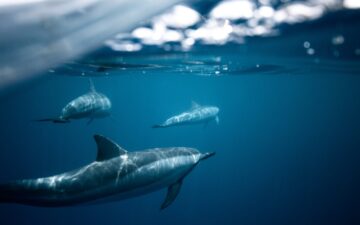Breaking Down Climate Geoengineering Part 3
Part 1: Endless Unknowns
Part 2: Ocean Carbon Dioxide Removal
Part 4: Considering Ethics, Equity, and Justice
Solar Radiation Modification (SRM) is a form of climate geoengineering that aims to increase the amount of sunlight reflected back into space – to reverse the warming of the planet. Increasing this reflectivity decreases the amount of sunlight that makes it to the atmosphere and the Earth’s surface, artificially cooling the planet.
Through natural systems, the Earth reflects and absorbs sunlight to maintain its temperature and climate, interacting with clouds, airborne particles, water, and other surfaces – including the ocean. Currently, there are no proposed natural or enhanced natural SRM projects, so SRM technologies primarily fall into the mechanical and chemical category. These projects predominantly seek to alter the natural interaction of the Earth with the sun. But, decreasing the amount of sun that reaches the land and ocean has the potential to upset natural processes that depend on direct sunlight.
Proposed mechanical and chemical SRM projects
The Earth has a built-in system that controls the amount of radiation from the sun that comes in and goes out. It does this by reflecting and redistributing the light and heat, which helps regulate the temperature. Interest in mechanical and chemical manipulation of these systems ranges from releasing particles through stratospheric aerosol injection to developing thicker clouds close to the ocean through marine cloud brightening.
Stratospheric Aerosol Injection (SAI) is the targeted release of airborne sulfate particles to increase the reflectivity of the earth, reducing the amount of sunlight that reaches the ground and the heat trapped in the atmosphere. Theoretically similar to using sunscreen, solar geoengineering aims to redirect some sunlight and heat outside of the atmosphere, reducing the amount that reaches the surface.
The Promise:
This concept is based on the natural phenomena that occur in tandem with intense volcanic eruptions. In 1991, the eruption of Mount Pinatubo in the Philippines spewed gas and ash into the stratosphere, distributing mass amounts of sulfur dioxide. Winds moved the sulfur dioxide around the globe for two years, and the particles absorbed and reflected enough sunlight to reduce global temperatures by 1 degree Fahrenheit (0.6 degrees Celsius).
The Threat:
Human-created SAI remains a highly theoretical concept with few conclusive studies. This uncertainty is only exacerbated by unknowns about how long injection projects would need to occur and what happens if (or when) SAI projects fail, are discontinued, or lack funding. SAI projects have a potentially indefinite need once they begin, and may become less effective over time. Physical repercussions to atmospheric sulfate injections include the potential for acid rain. As seen with volcanic eruptions, the sulfate particles travel around the world and may deposit in regions typically unaffected by such chemicals, altering ecosystems and changing soil pH. A proposed alternative to aerosol sulfate is calcium carbonate, a molecule that is expected to have a similar impact but not as many side effects as sulfate. However, recent modeling studies indicate calcium carbonate may negatively impact the ozone layer. Reflection of incoming sunlight poses further equity concerns. The deposition of particles, who origin is unknown and possible global, may create actual or perceived disparities that could worsen geopolitical tensions. An SAI project in Sweden was put on pause in 2021 after the Saami Council, a representative body of Indigenous Saami people of Sweden, Norway, Finland, and Russia, shared concerns about human intervention in the climate. The Council’s vice president, Åsa Larsson Blind, stated that the values of the Saami people to respect nature and its processes directly clashed with this type of solar geoengineering.
Surface Based Brightening/Albedo Modification aims to increase the reflectivity of the earth and decrease the amount of solar radiation that remains in the atmosphere. Rather than using chemistry or molecular methods, surface based brightening seeks to increase the albedo, or reflectivity, of the earth’s surface through physical alterations to urban areas, roads, agricultural land, polar regions, and the ocean. This may include covering these regions with reflective materials or plants to reflect and redirect sunlight.
The Promise:
Surface based brightening is expected to offer direct cooling properties on a local basis- similar to how a tree’s leaves can shade the ground beneath it. This type of project may be implemented on smaller scales, i.e. country to country or city to city. In addition, surface based brightening may be able to help reverse the increased heat many cities and urban centers experience as a result of the urban island heat effect.
The Threat:
On a theoretical and conceptual level, surface based brightening seems like it could be implemented quickly and efficiently. However, the research on albedo modification remains thin and many reports indicate the potential for unknown and messy effects. Such efforts are unlikely to offer a global solution, but uneven development of surface based brightening or other solar radiation management methods could have unwanted and unpredicted global effects on circulation or the water cycle. Brightening the surface in certain regions may alter regional temperatures and alter the movement of particles and matter to problematic ends. In addition, surface based brightening may cause inequitable development on a local or global scale, increasing the potential for shifting power dynamics.
Marine Cloud Brightening (MCB) purposefully utilizes sea spray to seed low-level clouds over the ocean, encouraging the formation of a brighter and thicker cloud layer. These clouds prevent incoming radiation from reaching the land or sea below in addition to reflecting the radiation back toward the atmosphere.
The Promise:
MCB has the potential to lower temperatures on a regional scale and prevent coral bleaching events. Research and early tests have seen some success in Australia, with a recent project at the Great Barrier Reef. Other applications could include seeding clouds over glaciers to stall sea ice melt. The currently proposed method uses ocean seawater, reducing its impact on natural resources and could be performed anywhere in the world.
The Threat:
Human understanding of MCB remains highly uncertain. The tests that have been completed are limited and experimental, with researchers calling for global or local governance on the ethics of manipulating these ecosystems for the sake of protecting them. Some of these uncertainties include questions about the direct effect of cooling and reduced sunlight on local ecosystems, as well as the unknown effect of increased airborne particles on human health and infrastructure. Each of these would depend on the makeup of the MCB solution, the deployment method, and the amount of MCB anticipated. As the seeded clouds move through the water cycle, the water, salt, and other molecules will return to the earth. Salt deposits may affect the built environment, including human housing, by speeding up deterioration. These deposits may also alter soil content, affecting nutrients and the ability for plants to grow. These broad concerns scratch the surface of the unknowns accompanied with MCB.
While SAI, albedo modification, and MCB work to reflect incoming solar radiation, Cirrus Cloud Thinning (CCT) looks at increasing outgoing radiation. Cirrus clouds absorb and reflect heat, in the form of radiation, back to the earth. Cirrus Cloud Thinning has been proposed by scientists to reduce the heat reflected by these clouds and allow more heat to exit the atmosphere, theoretically decreasing temperatures. Scientists anticipate thinning out these clouds by spraying the clouds with particles to reduce their lifespan and thickness.
The Promise:
CCT promises to reduce global temperatures by increasing the amount of radiation to escape the atmosphere. Current research indicates that this modification may speed up the water cycle, increasing precipitation and benefit areas prone to drought. New research further indicates that this temperature decrease may help slow sea ice melt and aid in maintaining the polar ice caps.
The Threat:
The 2021 Intergovernmental Panel on Climate Change (IPCC) report on climate change and the physical sciences indicated that CCT is not well understood. Weather modification of this type may change precipitation patterns and cause unknown impacts to ecosystems and agriculture. The currently proposed methods for CCT include spraying the clouds with particulate matter. While a certain amount of particles are expected to contribute to thinning the clouds, over injection of particles may seed the clouds instead. These seeded clouds may end up thicker and trap heat, rather than becoming thinner and releasing heat.
Space Mirrors are another method researchers have proposed to redirect and block incoming sunlight. This method suggests placing highly reflective objects in space to block or reflect incoming solar radiation.
The Promise:
Space mirrors are anticipated to decrease the amount of radiation entering the atmosphere by stopping it before it reaches the planet. This would result in less heat entering the atmosphere and cooling the planet.
The Threat:
Space based methods are highly theoretical and are accompanied by a lack of literature and empirical data. Unknowns about the impact of this type of project is only one part of the concerns held by many researchers. Additional concerns include the costly nature of space projects, the direct impact of redirecting radiation before reaching the earth’s surface, the indirect impact of reducing or removing starlight for marine animals that rely on celestial navigation, the potential termination risk, and the lack of international space governance.
Movement toward a cooler future?
By redirecting solar radiation to decrease planetary temperatures, solar radiation management attempts to answer a symptom of climate change rather than addressing the problem head on. This area of study is rife with potential unintended consequences. Here, a risk-risk assessment is crucial to determine if the risk of a project is worth the risk to the planet or the risk of climate change prior to implementing any project on a large scale. The potential for SRM projects to affect the entire planet shows the need for any risk analysis to include consideration for the risk to the natural environment, exacerbation of geopolitical tensions, and the impact on increasing global inequities. With any plan to alter the climate of a region, or the planet as a whole, projects must center considerations of equity and stakeholder involvement.
Broad concerns about climate geoengineering and SRM, in particular, indicate a need for a robust code of conduct.
Key Terms
Natural Climate Geoengineering: Natural projects (nature-based solutions or NbS) rely on ecosystem-based processes and functions that occur with limited or no human intervention. Such intervention is usually limited to afforestation, restoration or conservation of ecosystems.
Enhanced Natural Climate Geoengineering: Enhanced natural projects rely on ecosystem-based processes and functions, but are bolstered by designed and regular human intervention to increase the ability of the natural system to draw down carbon dioxide or modify sunlight, like pumping nutrients into the sea to force algal blooms that will take up carbon.
Mechanical and Chemical Climate Geoengineering: Mechanical and chemical geoengineered projects rely on human intervention and technology. These projects use physical or chemical processes to effect the desired change.







